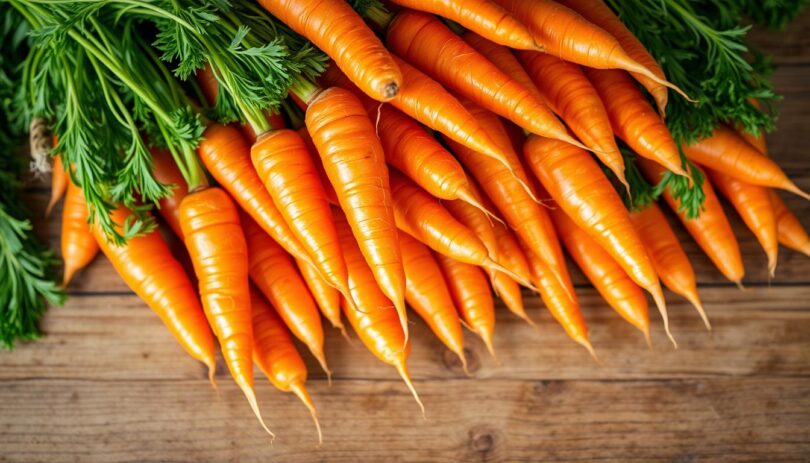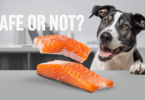68% of pet owners admit they’re unsure which vegetables are safe for their furry companions. This uncertainty often leads to missed opportunities for nutritious snacking. Crunchy, vibrant carrots, for instance, aren’t just a staple in human diets—they can also play a role in balanced pet nutrition when handled correctly.
Raw carrots offer a low-calorie option packed with vitamins A and K, along with fiber that supports digestion. Many pets enjoy their satisfying texture, which can even help clean teeth. However, preparation matters: chopping them into bite-sized pieces reduces choking risks.
Before introducing any new food, consulting a veterinarian ensures it aligns with a pet’s specific health needs. While these orange veggies are generally safe, moderation remains key to avoiding digestive upset. Their natural sweetness makes them a popular choice for training rewards or casual treats.
This guide explores how to safely incorporate carrots into a pet’s diet, preparation tips, and creative ways to serve them. From nutritional benefits to portion control, readers will learn how to turn this humble vegetable into a wholesome snack.
Understanding the Nutritional Benefits of Carrots for Dogs
Vibrant orange carrots offer more than crunch—they're loaded with essential vitamins for pets. These root vegetables contain beta-carotene, which converts to vitamin A in a pet's body. This nutrient supports vision health in animals much like it does for humans.
Essential Vitamins and Minerals
Carrots provide potassium for muscle function and vitamin B6 for energy metabolism. Studies show diets rich in yellow-orange vegetables may lower risks of chronic conditions. Veterinarians often recommend these veggies as low-calorie additions to dog food for balanced nutrition.
Fiber and Digestive Health
The natural fiber in these vegetables aids digestion by promoting regular bowel movements. Research indicates fiber-rich snacks help maintain healthy gut bacteria in pets. Always introduce new foods gradually to avoid stomach upset.
Combined, these nutrients create a wholesome snack supporting overall wellness. While treats shouldn't replace meals, they complement a diet when given properly. Always consult your vet about portion sizes and frequency.
Safety Considerations When Feeding Carrots to Dogs
Safety should always come first when sharing human foods with canine companions. While these crunchy vegetables offer nutritional perks, improper handling or serving methods could pose risks. Understanding proper preparation techniques ensures pets enjoy their snacks without hazards.
Choking Hazards and Serving Sizes
Whole carrots or thick chunks may lodge in a pet’s throat. Cutting them into ¼-inch slices minimizes this danger while aiding digestion. Small breeds like Chihuahuas need matchstick-sized pieces, while larger dogs like Labradors can handle slightly bigger portions.
Always wash carrots thoroughly to remove pesticides and soil. Residual dirt might contain harmful bacteria or parasites. Organic options reduce chemical exposure but still require rinsing.
Veterinarians suggest limiting carrot treats to 10% of daily calories. For a 30-pound dog, this equals about two tablespoons of chopped pieces. Pets on specialized diets should have their portions approved by a professional first.
If coughing, vomiting, or lethargy occurs after feeding carrots, contact your veterinarian immediately. These symptoms could indicate choking or intestinal blockage requiring urgent care.
The natural crunchiness helps scrape plaque from dog teeth during chewing. However, this benefit only applies when pieces are sized appropriately. Pair these snacks with regular dental checkups for optimal oral health.
Can Dogs Eat Carrots Raw? Exploring Raw and Cooked Options
Pet nutrition often sparks debates about raw versus cooked vegetables. Both forms offer unique advantages depending on a pet's needs and health status. Understanding these differences helps owners make informed choices.
Comparing Nutrient Retention in Raw vs. Cooked Carrots
Raw vegetables preserve heat-sensitive nutrients like vitamin C and certain enzymes. However, lightly steaming carrots increases beta-carotene absorption by up to 30%, according to veterinary nutrition studies. This antioxidant converts to vitamin A, supporting immune function and eye health.
Crunchy raw pieces act as natural toothbrushes during chewing. They’re ideal for active pets needing mental stimulation. Softened cooked versions suit senior animals or those with dental issues. Always cool boiled carrots to room temperature to prevent mouth burns.
Preparation methods impact safety and digestibility. Chop raw sticks into manageable pieces to prevent choking. For cooked options, avoid oils and seasonings. Steam or boil until tender but not mushy—overcooking destroys nutrients.
Veterinarians recommend rotating between raw and cooked forms based on individual needs. Limit treats to 10% of daily calories, adjusting portions for breed size. Consult your vet if introducing carrots to pets with diabetes or weight concerns.
Proper Preparation and Serving Techniques
Transforming fresh carrots into pet-friendly snacks requires careful handling. Follow these vet-approved methods to maximize safety and nutritional value while minimizing risks.
Washing, Cutting, and Portioning Guidelines
Start by scrubbing whole carrots under cool running water to remove dirt. Use a vegetable brush for thorough cleaning, especially near the stem area. Peel thick-skinned varieties if preferred, though the outer layer contains valuable nutrients.
Slice cleaned carrots into ¼-inch rounds or sticks. For smaller breeds, cut pieces lengthwise into matchstick shapes. Always remove green tops, as they may contain compounds that upset sensitive stomachs.
Serve plain—never add oils, salt, or seasonings. These additives can cause digestive issues or sodium imbalances. Frozen carrot chunks make soothing teething aids for puppies during summer months.
Tailoring Carrot Portions to Different Dog Sizes
Adjust quantities based on your pet’s weight and chewing habits. A Yorkshire Terrier might enjoy one teaspoon of grated carrot mixed with meals, while a Golden Retriever could handle two tablespoons of sliced pieces.
Follow these general guidelines:
- Under 15 lbs: 1-2 small pieces daily
- 15-50 lbs: 1-2 tablespoons
- Over 50 lbs: ¼ cup maximum
Introduce new snacks gradually—offer a single piece first to monitor tolerance. Pair carrot treats with regular dental care, as fibrous textures complement brushing routines. Always consult your veterinarian when adjusting dietary plans.
Health Benefits for Dental and Vision Support
Crunchy snacks do more than satisfy hunger—they can boost your pet’s health in unexpected ways. Carrots deliver dual advantages by promoting oral hygiene and supporting vital sensory functions. These benefits make them a strategic choice for proactive pet owners.
Natural Teeth-Cleaning Properties
The fibrous texture of raw carrots acts like nature’s toothbrush. As pets chew, the abrasive surface scrapes away plaque buildup. A 2021 veterinary study found animals given crunchy vegetables twice weekly showed 20% less tartar accumulation compared to control groups.
For optimal dental benefits, offer carrot sticks two to three times weekly. Supervise chewing sessions to ensure safe consumption. Pair these snacks with regular brushing for comprehensive oral care.
Support for Eye Health and Vision
Beta-carotene—the pigment giving carrots their orange hue—converts to vitamin A during digestion. This nutrient maintains retinal health and night vision capabilities. Research shows adequate vitamin A intake reduces risks of age-related eye issues in animals by 15%.
One medium carrot provides 200% of a 30-pound dog’s daily vitamin A needs. Balance portions to avoid over-supplementation. Combine with leafy greens like spinach for enhanced nutrient absorption.
By addressing both dental and visual wellness, carrots serve as multifaceted treats. Their combination of mechanical cleaning action and essential vitamins makes them uniquely valuable in preventive pet care.
Integrating Carrots into Your Dog's Balanced Diet
Balanced nutrition for pets involves more than just kibble—it’s about smart supplementation. Fresh vegetables like carrots work best when used as occasional enhancements rather than meal replacements. Most commercial pet foods already contain essential nutrients, making these crunchy additions a bonus rather than a necessity.
Moderation proves critical. Veterinarians recommend keeping treats under 10% of daily calories to maintain nutritional equilibrium. For a 20-pound animal, this equals roughly one baby carrot or two tablespoons of shredded pieces. Larger breeds might handle slightly more, while puppies need pea-sized portions to avoid overwhelming their developing digestive systems.
Raw slices offer dental benefits through their abrasive texture, while steamed versions suit pets with sensitive teeth. Mix grated pieces into regular meals for added fiber, or freeze them into summer snacks. Always introduce new foods gradually—start with a teaspoon-sized portion and monitor for loose stools.
Consult your vet before making dietary changes, especially for animals with weight issues or chronic conditions. Pair these orange veggies with protein-rich foods to create balanced snacks. Remember: variety matters. Rotate carrot treats with other vet-approved options like green beans or apples for diverse nutrient intake.
Creative Ways to Add Carrots to Dog Meals and Treats
Spicing up mealtime doesn’t require fancy ingredients—simple carrots offer endless possibilities for pet-friendly creativity. These versatile vegetables blend seamlessly into daily routines while adding nutritional value. Let’s explore inventive methods to turn ordinary snacks into engaging experiences.
Mixing Carrots with Regular Food
Shredded raw carrots add crunch when sprinkled over kibble. For pets preferring softer textures, steam slices and mix with brown rice or lean ground turkey. Rotate between raw and cooked versions to maintain interest—some animals enjoy the variety.
Using Carrots in DIY Treats and Toys
Create frozen carrot popsicles by blending puréed cooked carrots with unsweetened yogurt. Pour into ice cube trays for portion-controlled summer snacks. For chew enthusiasts, stuff large carrot sticks into rubber toys like KONGs—the gnawing action cleans teeth naturally.
Try these simple recipes:
- Carrot-Oat Bites: Combine grated vegetables with rolled oats and egg, bake at 350°F for 15 minutes
- Puppy Teething Sticks: Freeze thick carrot sticks for soothing gum relief
Always use plain ingredients without additives. Start with small portions to gauge tolerance. Pair these ideas with regular vet checkups to ensure dietary compatibility.
When Carrots Might Not Be Suitable for Your Dog
While carrots offer numerous benefits, certain situations require pet owners to exercise caution. Specific health conditions and individual sensitivities may make this vegetable less ideal for some animals. Recognizing these scenarios helps prevent unintended consequences.
Considerations for Dogs with Health Concerns
Pets with diabetes or obesity need careful monitoring of carbohydrate intake. Though low in calories, carrots contain natural sugars that can affect blood glucose levels. Veterinary nutritionists recommend limiting portions to occasional treats for these cases.
Large uncut pieces pose digestion risks. Always slice vegetables into manageable sizes to prevent intestinal blockages. Processed carrot products like carrot cake often contain harmful ingredients—sugar, raisins, or nutmeg—that should never enter a pet's diet.
Allergy and Sensitivity Indicators
Watch for itching, gastrointestinal upset, or skin irritation after introducing carrots. These symptoms may signal food sensitivities. Fiber-rich snacks generally aid digestion, but sudden increases can temporarily disrupt gut balance.
Start with tiny portions and observe reactions over 24 hours. Consult a veterinarian if adverse effects persist. Pair this vegetable with other vet-approved ingredients to maintain dietary variety while prioritizing safety.
Parting Thoughts on Healthy Snacking for Your Canine Companion
Navigating treat options for four-legged friends becomes simpler when focusing on nutrient-rich choices. Crunchy vegetables like carrots deliver vitamins A and K while supporting dental hygiene through natural chewing action. Their fiber content aids digestion, making them a smart addition to meals when prepared safely.
Always slice these orange veggies into bite-sized pieces to prevent choking—matchstick cuts work best for small breeds. While the nutritional perks are clear, moderation remains critical. Treats should complement, not replace, balanced dog food formulas tailored to your pet’s needs.
Experiment with creative serving methods: freeze grated carrots into summer popsicles or mix steamed pieces into homemade biscuits. Pet owners might discover their pup prefers specific textures or preparations. Remember to consult a veterinarian before altering diets, particularly for animals with allergies or chronic conditions.
By prioritizing proper portioning and preparation, these vibrant vegetables become more than snacks—they’re tools for promoting lifelong wellness. Share your experiences with carrot-based treats in the comments below. What creative recipes has your furry friend enjoyed?
FAQ
Are raw carrots safe for pets to consume?
Yes, uncooked carrots are generally safe for most canines. They’re low in calories and rich in nutrients like beta-carotene. Always supervise pets during snack time to prevent choking.
How do carrots support a pet’s dental hygiene?
Crunchy textures help scrape plaque off teeth, promoting oral health. However, they shouldn’t replace regular brushing or veterinary dental care.
Should carrots be cooked before feeding them to smaller breeds?
Softening carrots through steaming or boiling makes them easier to chew for tiny dogs. Cut them into bite-sized pieces to minimize choking risks.










Leave a Comment